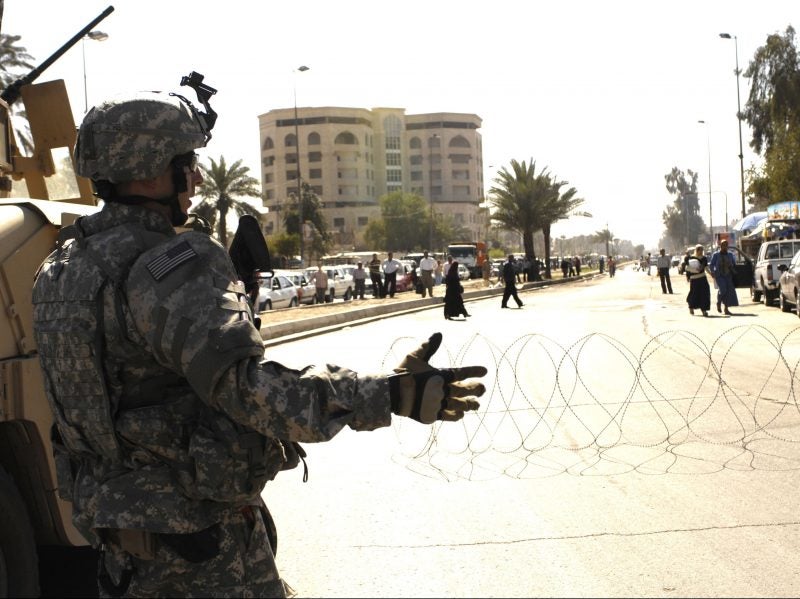
Landmines are one of the most effective tools in a military’s arsenal when it comes to area denial and slowing the advance of an adversary. Landmines can also be used to guard static positions, making them a valuable piece of kit in a defending a force’s arsenal.
Despite this, landmines continue to scar battlefields and present a threat long after a conflict is over. However, one low-tech alternative that is almost as effective may have been in use with the military since WWI: barbed wire.
Although it may seem over-simplistic, the main use of landmines is to defence static positions or funnel an adversary into an area to deny approach from alternative directions. In this regard, barbed wire could perform a similar job cheaply.
Although more time-consuming than laying a minefield, if laid correctly barbed wire is an effective means of defending a fixed position and is a tool that most military engineers are already trained to lay. Working similarly to the concrete tank barriers of the WW2 era, barbed wire denies access to an area, not through the threat of explosives but rather by creating a physical barrier between two points.
On another note, the risks of deploying and recovering mines are also far greater for friendly personnel than alternatives such as barbed wire or other fixed barriers like gabions or concrete blocks.
Examples of the use of barbed wire to defend fixed positions are too numerous to count, lining the no man’s land between trenches in WWI to the modern day where it is a common fixture at military checkpoints across the world.
As International Institute of Strategic Studies (IISS) land warfare research fellow Ben Barry explained, if laid in enough density, barbed wire can be used to stop vehicles, with the wire itself coiling around and stopping tracks or wheels – from moving, achieving the same job as a land mine without the deadly force.
Once in the mechanism of a vehicle like a tank, the wire will wrap around the running gear, leaving the vehicle immobile until it has been removed.
Barry detailed several instances where barbed wire has been used to effectively defend a static position where mines have also created a similar effect, notably in Bosnia where the British Army would set up a box of concertina wire around Warrior infantry fighting vehicles when stopping for the night. The UN peacekeeping mission in Mali where convoys often travel large distances stopping for the night in potentially vulnerable areas could take a similar approach.
Barry said: “If I was if I was a US brigade commander in Korea or indeed a French battalion commander in Mali, I’d be looking to use a lot of barbed wire.”
Barbed wire also has another advantage over landmines when it comes to area denial in that once the defending force has left the wire can be safely removed or simply left behind to be sold for scrap or recycled by the local population. Unlike land mines, which left unremoved present a constant threat to a local population, rows of barbed wire with the right care can be safely removed with no-to-little injuries and reused for farming or other purposes.
However, simply replacing landmines with barbed wire is not all that simple. As one member of the British Army told Army Technology, carrying the quantities of barbed wire needed to deliver the same scale of area denial would become a challenge in of itself and hamper the mobility of a formation.
The British Army has used barbed wire in recent conflicts such as Afghanistan and Iraq to secure fixed positions and defend static areas. However, the British Army source explained that is would be unlikely the army would look to deploy barbed wire to secure overnight positions as was the case in Bosnia.
Faced with a barbed-wire barrier now, the British Army’s main countermeasure is the Trojan combat engineering vehicle which can be used to remove the wire, allowing the rest of the formation to advance. In other cases, a slow-moving tank can be used to flatten to the barbed wire obstacle without getting it jammed in the running gear – although this method can still lead to the vehicle still becoming stuck.
Despite the danger of unexploded ordnance, the most effective means at securing an area remains a combination of both wire and landmines; the concealed nature of mines mean adversaries are wary to enter an area due to the unseen nature of the threat. This combined with barbed wire means an enemy force has two obstacles to cross – with each acting as a redundancy for the other and slowing an advance drastically.
Outside of barbed wire, the UK’s Defence and Security Accelerator (DASA) in 2018 launched a competition to develop novel passive, autonomous or semi-autonomous counter mobility (CMob) area denial capabilities that can slow or obstruct tanks while minimising collateral damage caused by existing methods such as landmines.
In 2019 the competition entered its second phase with the focus being to disrupt adversaries and slow them down, to divert enemy forces to a desired area, slow an attacker within a specified area, and to block attackers from being able to use specific avenues of approach.
Solutions under consideration from the competition include physical barriers, encompassing anything from novel tank traps to high-strength adhesives, to invisible barriers that could take the form of electromagnetic pulse (EMP) based weapons to acoustic or light-based devices.
High tech or low tech, replacing landmines outright is a difficult task to achieve. Despite the dangers associated with their use, advances in technology and self-destruction mechanisms could make them safer in the long run.
Despite this, Barry made clear: “Having seen civilians blown up on land mines and having had a couple of my own vehicles blown up on landmines, fortunately without any serious casualties, a world without landmines is a safer world. Absolutely no doubt about that at all.”



